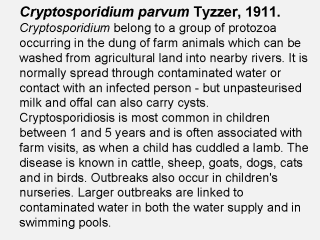| front |1 |2 |3 |4 |5 |6 |7 |8 |9 |10 |11 |12 |13 |14 |15 |16 |17 |18 |19 |20 |21 |22 |23 |24 |25 |26 |27 |28 |29 |review |
 |
There
is no reliable treatment for cryptosporidium enteritis yet agents like paromomycin,
atovaquone, nitazoxanide and azithromycin are sometimes used The simple life cycle is completed in one host. The transmissible stage is the oocyst (spore). After ingestion each oocyst releases 4 motile sporozoites into the small intestine. These attach to the gut wall and develop by 2 asexual stages, producing merozoites and a sexual stage producing karyosomes (zygotes) which sporulate to segregate into 2 types of oocysts. These stages develop just inside the outer walls of the cells lining the intestine. The infection is intracellular but it is extracytoplasmic, i.e., the protozoa do not penetrate deeply into the host's cells. Oocysts sporulate within the intestine and 2 types are segregated. The thin-walled type releases more sporozoites in the instestine (autoinfection), and the thick-walled types are excreted in feces. They do not need any further maturation as do many other Sporozoa. One huge problem is the tiny size 5x 5 microns of the parasite along with its resistence to chlorine shared with Entamoeba, Giardia and Cyclospora. Filters that have passed hundreds of liters of water can be cut up, eluted with detergent and separated by centrifuge gradient to obtain samples for microscopic diagnosis. |